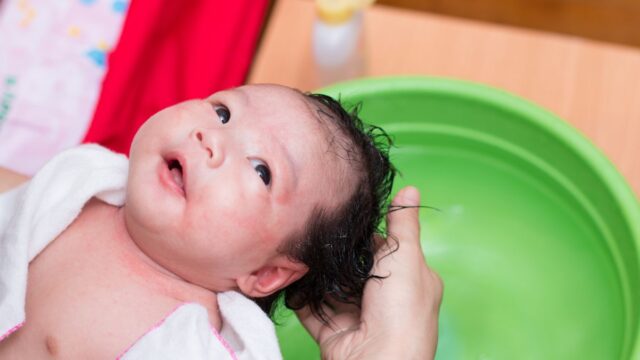Bathing your newborn can be an enjoyable bonding experience for both you and your baby, but it can also be a stressful time for new parents. Learning the necessary steps and gathering the essential supplies will ensure a safe and soothing bathing experience for your little one. Adequate preparation and understanding of how to bathe a newborn will help you feel confident and comfortable in providing the best care for your child.
To help guide new parents, The Channel 46 spoke to Apoorva Pandey, the Brand Head of Baby Forest Ayurveda to talk about the best way to give a newborn a bath.
The process of bathing a newborn involves more than just gentle scrubbing with warm water and soap. Ensuring that the water temperature is appropriate, using safe and baby-friendly products, and maintaining a relaxed and secure environment during the bath is equally important. Knowledge of proper baby bath safety procedures and tips will ensure your baby’s bathing experience is not only pleasant but also safe and nurturing.
Key Takeaways
- Preparation and understanding are essential for a successful newborn bathing experience.
- Use safe and appropriate baby products when bathing your newborn.
- Keep your baby’s environment relaxed and secure during bath time.
Understand the Essentials of Baby Bath
To ensure the comfort and safety of your newborn during bath time, it’s essential to learn a few basic principles. One important aspect is that newborns don’t require daily baths. Baby Forests recommends bathing your baby around 2-3 times per week. Overbathing can dry out a baby’s skin and may remove important skin protectants like vernix.
Before starting, gather all the necessary supplies, including a clean towel, sulfate-free natural baby soap or baby wash, a large basin or baby bathtub, warm water, and washcloths. Checking the water temperature is crucial: use your elbow or a bath thermometer to determine if the water is lukewarm and comfortable. The ideal water temperature for a baby bath is around 37-38°C.
When the umbilical cord stump is still attached, choose a sponge bath for your newborn. Support your baby’s neck and head while using a damp washcloth to gently clean their face, neck, chest, and diaper area. Keep the cord stump dry and clean; use plain water and cotton wool to prevent infection. Once the umbilical cord has fallen off, you can transition to tub baths.
Choose natural baby shampoo and mild cleansers that are free from fragrances and harsh chemicals to prevent irritation. While bathing your baby, maintain a firm grip and never leave them unattended, even for a moment. Infants can drown quickly in shallow water. Ensure that the room temperature is warm and free of drafts to keep your baby comfortable during and after the bath.
After bath time, gently pat your baby’s skin dry with a soft towel, paying close attention to skin folds and creases. Apply a gentle, baby body lotion or moisturizer if your baby has dry skin or eczema. Then, place a clean diaper and dress them in comfy clothes.
Incorporating gentle massages can also be a great addition to bath time, as it fosters bonding and relaxation. Just ensure you use baby-safe massage oils that have hypoallergenic properties. By following these essential steps, you can make bath time a pleasant and safe experience for both you and your newborn.
Baby Bath Safety Procedures and Tips
Bathing your newborn baby can be a delicate and sometimes nerve-wracking experience, but following a few simple tips will ensure that you’re well-prepared. Remember, safety is always the top priority when it comes to your little one.

- Before starting, choose a safe bathing location to make the baby’s bath time a comfortable and pleasant experience. Ensure the room is sufficiently warm and draft-free, as a wet baby can be easily chilled.
- Fill the baby’s tub with just enough warm water to wash your baby—usually around 2 to 3 inches deep is sufficient. The appropriate temperature for bath water is around 100 F (38°C). You can use a bath thermometer to check the water temperature and make sure it’s safe for your baby.
- When placing your baby in the tub, make sure to hold their upper arm and support their head and shoulders. This will help prevent any slips or accidents. Swish the water gently over your baby, using a soft washcloth and mild, unscented liquid cleansers to avoid any skin irritations or rashes.

- During the first month, you can practice “topping and tailing,” which means cleaning your baby’s face, neck, hands, and bottom instead of a full bath. Avoid using chemical-based powders or lotions that might lead to rashes or allergic reactions.
- Always be extra cautious around hot water, and never leave your baby unattended in the tub, even for a moment, as drowning can happen quickly and silently. After the bath, gently pat your baby dry with a soft towel, making sure to get into all the creases and folds to avoid any unnecessary discomfort or irritation.
- Lastly, dress your baby in clean clothes, and remember that you don’t need to wash their hair every day—once or twice a week is enough. Your baby might be tired after a bath, so take advantage of this time to bond and settle them down for a nap or bedtime.
Open up like never before and participate in conversations about beauty, entrepreneurship, mental health, menstrual & sexual health, and more. Desi women, join our community NOW!

